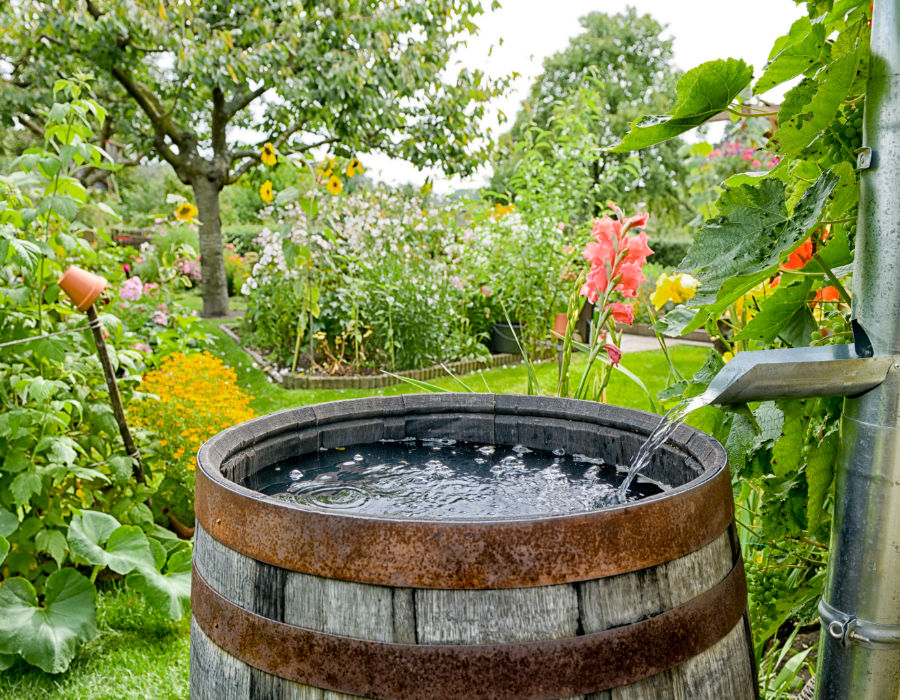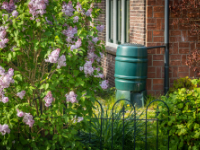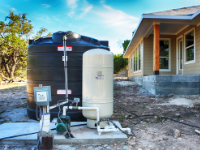
Rainwater harvesting can benefit you, your community, and the environment.
The Northwest has a rainy reputation. At first thought, with nearly three feet of rain annually, that would seem correct, but it doesn’t tell the whole story. 92% of our rain comes in non-summer seasons, leaving only 8% for the summer months when it’s most needed. That’s less than the precipitation in Tuscon, AZ, during the same months. As a result, rainwater collection has become increasingly popular as a supplemental water source for residents in the Northwest.
Is rainwater harvesting right for you?
Rainwater harvesting refers to the collection and storage of rainwater for future use, mainly for watering lawns and gardens. While collected rainwater can be used for drinking, it comes with strict regulations that make it complex and expensive, rendering it impractical for most homeowners. Systems designed to make rainwater potable (safe for drinking) can cost $20,000 or more and require significant ongoing maintenance to ensure the water remains safe for consumption. If you are interested in researching harvesting systems for drinking water, you can find the Washington State Department of Health Guidance Manual here: https://doh.wa.gov/sites/default/files/legacy/Documents/Pubs/331-085.pdf..
Rainwater harvesting may reduce the cost of municipal water by reducing its use for lawns and gardens. It also has benefits beyond your yard. It can help your community and the environment as a whole. Stormwater ranks among the primary sources of water pollution in our communities. As water travels over rooftops, streets, landscaping, and parking lots, it collects and transports pollutants into nearby waterways. Since stormwater often remains untreated after it flows into street drains, it poses a significant threat to water quality.
What are the benefits for your yard?
- It can provide water for gardens and lawns in dry summer months.
- It can help divert water away from your house.
- You may save on your water bill by reducing your public water use.
How can harvesting rainwater benefit your community and environment?
- It can reduce stormwater runoff, reducing pollutants carried to our waterways.
- It can reduce erosion and flooding caused by stormwater runoff.
- It can lessen the strain on sewer systems during rain events, helping reduce the risk of overflows running into streams, lakes, or marine waters.
There are two basic rainwater harvesting systems for your yard, above-ground and underground. In most cases, above-ground systems collect rainwater from the roof. Underground systems can collect rainwater from the surface and the roof. The cost of both systems is based on the size of the containers and the complexity of water collection and distribution. Underground systems offer a variety of benefits, but are considerably more expensive. The installation requires excavation, underground plumbing for water collection and distribution, and power for pumping.
Above-ground Systems
These systems have containment tanks sitting above ground that collect rainwater from your roof. This can be as simple as having rain barrels at your gutter downspouts or funneled to a single, larger water tank. One challenge with above-ground systems is that they are visible. Rain barrels are available in many attractive designs and may be enhanced with plantings if desired. Larger, single tanks create more of a challenge to discreetly place them and hide them with plantings so they are less of an eyesore.
In most cases, a gravity-only system will work, but sometimes a pump-assisted system may be needed. Many of our yards have hillsides, which may require rainwater to be pumped into the tank or our collected water to be pumped out to our yards.

Rain Barrels
The cost of adding rain barrels to downspouts is based on the cost of the rain barrels, how many you want, and how the water is distributed from them. Rain barrels are typically about 50-100 gallons and cost $100 - $200. They come in a variety of attractive designs. See the options below.
Wayfair
Amazon
Home Depot

Single-tank
The cost of a single-tank system is more costly due to the cost of the container, which can hold 1,000 gallons or more, and the complexity of the collection and distribution systems. A 1,000-gallon tank can cost $1,500 or more. If you require or want one, a gravity-assisted system will incur additional installation, electricity, and maintenance costs.
Below are links to large water tanks.
Rain Harvest
Rain Water Equipment
Tank Depot
Underground Systems
Due to the cost of installation, underground systems are much less common than above-ground systems. An underground harvesting system can cost $8,000-$30,000. With that said, there are benefits to an underground system.
- You can collect substantially more water.
- It is hidden and lawns and gardens can be planted on top of it.
- The system adds protection from damage, pests, and freezing.
- Improved overall efficiency
For a comparison of above-ground and underground water harvesting systems, checkout this great blog post at Freshwatersystems.com
If you would like to do more research on rainwater harvesting, below are links to good information.
We would love to help you with your landscape project. Contact Us here to request a consultation.

